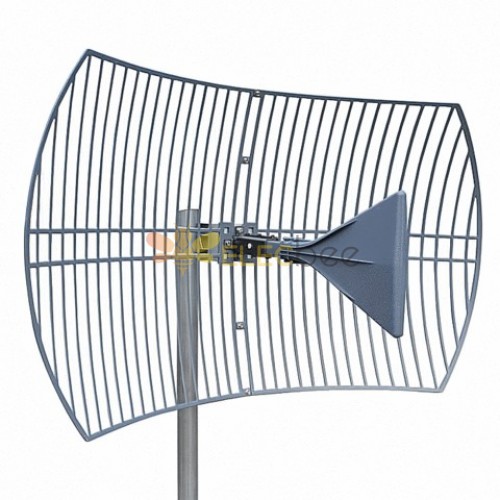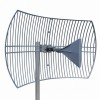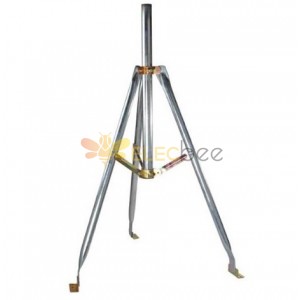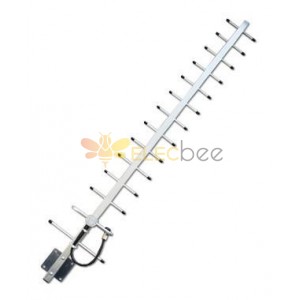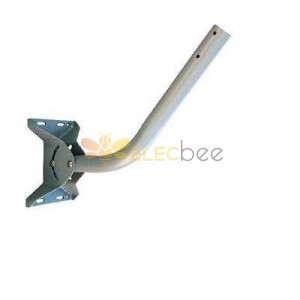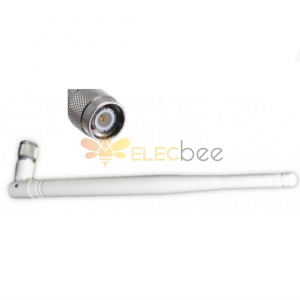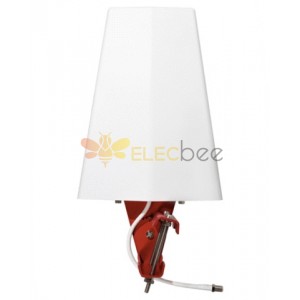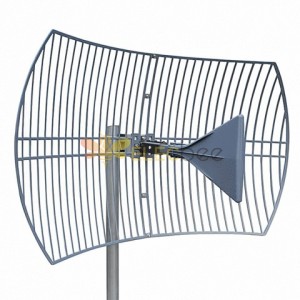RF Boost long range cellular and wi-fi grid parabolic antenna / aerial is an ultra wide band cell phone and wifi antenna that ensures you get a quality wifi and cellphone signal to enjoy top high speed connection for your wifi or mobile coverage needs.
Wide Band 600-6500 MHz (600 MHz to 6.5 GHz) 3G, 4G, LTE, 5G Directional Antenna (50 Ohm). Up to 26 dBi Gain Longest Reach and Highest Gain Outdoor Mounting Antenna for all Cell and Wi-Fi networks.
This large diameter parabolic cell booster antenna is engineered using the latest patented technology capable of providing the best possible signal improvement functionalities. As an uninterrupted gain cellular antenna, it is the best of its kind in the market today.
Being an ultra directional antenna, it ensures high gain is achieved when pointed precisely towards the source of signal. Other than that, you don't really need to calibrate or adjust anything. External cell antenna tuning is not required. It simply provides the best possible gain that meets your needs.
Essentially, Ultra Wide Band Long Range Cellular Antenna works with diverse frequency bands, purposes, and industries including:
- Radio telescope.
- 2G/ 3G/ 4G/ 5G, CDMA, UMTS, ISM, GSM, LTE.
- Wi-Max.
- GPS.
- Aerospace exploration.
- Military.
- Homeland security.
- Cellular.
Ultra wideband long range antenna is also a weatherproof choice - perfect for the outdoors. It is made using the most reliable and durable materials that can withstand diverse elements outside.
Top continuous gain cellular coverage booster antenna.
This ultrawide band long range wifi and cell antenna remains the top choice for replacement in wifi booster kits and cell phone booster kits for best continuous coverage. It is designed using a unique patent that makes it possible for top directionality and high gain on virtually all available bands ranging from 600 MHz to 6500 MHz frequencies. Future-proofed with 5G Band 71 compatibility that includes 5G T-Mobile Band 71 Sub-6 Frequency.
Its radiation and continuous gain properties at times indicated as instantaneous gain ensure that the cellular signal booster antenna has the capability to effectively radiate at the right frequency range it was engineered for.
The long range antenna makes easy work of installation for everyone; it begins to operate right after unpacking for all devices falling anywhere within the 600MHz and 6500MHz spectrum. It also comes with a feature allowing for greater optimization of the upper and lower parts of the ultra-wide bandwidth. If you intend to use it immediately you don't really require any calibration or adjustment.
Technical Specifications:
- 600MHz-6500MHz Frequency Range.
- Vertical or Horizontal Gain Polarization.
- Gain: 15 dBi Low Freq./ 20 Mid Freq./ 25 High Freq.
- Half-power Beam Width (°) Low Bands: 20 Horiz., 23 Vert.
- Half-power Beam Width (°) Mid. Bands: 12 Horiz., 15 Vert.
- Half-power Beam Width (°) High Bands: 7 Horiz, 9 Vert.
- HFront-to-back Ratio: 20dB AVG.
- Impedance: 50 Ohm.
- VSWR: 1.6:1 / 1.4:1 AVG Max.
- 100W Input Power Max.
- DC Ground Lighting Protection.
- N-Female Connector.
- 24x39x16/ 60x99x40 (in/ mm) - dimensions when installed.
- 20x25x4/ 51x63x10 (in/ mm) - dimensions when boxed.
- Rated Wind Velocity 130 / 209 (MPH / KPH).
- Wind Load @ Rated Velocity 150 / 68 (M / K).
- 1.5-2.0 / 40-50 (in/mm) Mounting Mast Diam.
- Aluminum Reflector Material.
- Electrostatic Powder Coat Finish Reflector.
- ASA Anti UV Antenna System Radome Material.
- Flat Gray Antenna Color.
- IPX Weather Rated Water Resistance.
- -40 to +60 / -40 to +140(°C / °F) Operating Temperature.
- Made in USA with imported materials / parts.
Covered frequencies and bands.
Ultra wide-band antenna works with all carriers and frequencies in United States and Canada as well as virtually anywhere around the world. It works perfectly for boosting internet connection once you attach it to a working cellular or wifi modem. The long range cell phone signal antenna also works perfectly with all cellular signal boosters out there from HiBoost, SureCall, Cel-Fi, weBoost, and Wilson Electronics, among others.
All that is needed in the box.
Long range antenna comes in a packaging containing all that you need to put into work right away. Installation and assembling is super easy. You need to connect it to a cellular hotspot or cellular repeater/booster. Even so, a cell signal strength meter and cable are great to have.
Also works with Mofi 4500.
If you have a Mofi 4500, this ultra wide range mobile antenna comes in handy right away. It is a unique antenna and provides the best possible gain and perfect if you have been disappointed before by other types of similar antennas. It can easily pick up diverse carrier bands in United States, such as Band 12, 4 and 2 for T-Mobile users. Make the most of the Mofi to effectively make use of any of the supported bands as per the available signal strength appearing on the status page of the Mofi.
Cables and connection.
Essentially, it works with all cell phone signal boosters as far they are N-Female connectors. This means that all you require is a cable with N-Male as one of the connectors. For other cables you might have to pick the best according to exactly what you will be plugging into. For instance, devices such as Mofi have SMA-Female connectors inbuilt and the cable you end up using must be a perfect SMA-Male to fit.
Those intending to plug into devices such as Nighthawk M1 among other gadgets, all that is required are TS-9 connectors. It means an N-Male and SMA-Male configuration cable is okay. However, you might require a pigtail or adaptor SMA-Female to TS-9. This is important since TS-9 isn't a large connector and doesn't usually match with larger types of coaxial cables used to connect with the outdoor antenna.
For those who might have Quad Core RG6 cables for antenna up to 50 feet, it is worth noting that this is 50 Ohm antenna while the RG6 cables are generally for 75 Ohm antennas. You could go for adapters that would make it possible to effectively use the antenna but the best results will depend on the particular device you intend to connect the antenna with, and how you end up configuring the system.
Antenna Key Characteristics.
It is perfect for boosting Wi-Fi and cellular signals, from 2G, 3G to 4G LTE and 5G. It doesn't matter what model of cell phone you're using; the long range antenna will work with it perfectly well, including all carriers globally, such as AT&T, Verizon and T-Mobile for US users. The long antenna also supports all cell signal booster makes and brands, including HiBoost, Wilson Pro, Cel-Fi among others.
Highest possible gain is assured and much better than the most cellular signal antennas out there. It offers up to 26dB gain which is six times stronger than the typical Yagi antenna out there. With an adjustable feedhorn, it makes sure the gain can be boosted from any part of the spectrum as per your needs.
It is designed to last the longest possible time courtesy of an aluminum patented grid mesh capable of surviving the harshest possible elements such as unforgiving hurricane winds. Water that gets in the horn mostly dries up or drains out of the microscopic drain hole that is at the tip. Any residual water freezing inside of horn should not be of concern because material is strong enough to withstand expansion of small amount of water when it freezes.
Why is ultra wide band long range cellular antenna a superior product?
Exceptionally long range for widest frequency range (600-6500 MHz).
For those living in some of the hardest terrains where the cellular signal is spotty, the cellular outdoor Ultra Gain 26dB antenna ensures that you can find cell towers that could even be 10 miles from your office or home. In contrast, most Yagi antennas have a 2-5 mile range only. Secondly, it covers 2G, 3G, 4G, LTE, 5G frequencies between 600 MHz through 6500 MHz which is wider range than other antennas. It is so effective that dead zones will be easily turned around into areas with working cell signals while sections with poor to weak cellular coverage will have a reliable internet and voice quality.
Signal-Noise performance unequalled.
Ultra Wide Band Long Range Ultra-Gain 26 dB antenna comes in handy when it comes to enhancing the performance of any cell phone signal booster out there. In a situation where cellular towers are in competition and as a result cause so much noise, the antenna's directional attributes allow the device to connect directly with the proper cell tower you wish to access.
Directional field very narrow for best reception.
One of the reasons why this long range antenna is perfect for installers is its high gain uniqueness. When it comes to boosting virtually all the available carriers and one carrier or a number of them try to surpass the others, the antenna is designed to bypass any overwhelming tower and directly engage that particular carrier you intended to connect with but couldn’t. However, it must be pointed precisely to relevant tower using signal meter or spectrum analyzer. A smartphone in field test mode would do as well.
Quality make, low cost.
The long-range superior build quality of the ultra wide high gain parabolic grid antenna is designed in such a way that it protects the device against such debilitating elements as moderate-to-heavy tempests known to knock out antennas and damage their placement. It is similar or much better than other models in the market that mostly cost a lot more: BT974822 | BT512495 | BT974921 | G02 | GO2 | ANT66NF-GP | B07PQ978P9 | B07ZTRBTZ4 | B08FBN5LJ7 | B07NJNC3MV | B08R6Q13G5.
Adjustable feed-horn for maximizing Gain on specific frequencies.
This almost future-proof antenna covers continuous frequencies from 600 MHz to 6500 MHz or 6.5 GHz that includes cell and wifi bands. It offers huge optimal Gain up to 28 dBi. It can be customized for tuning further to specific frequencies you need for highest Gain on those frequencies. Adjustable knobs below antenna horn enable you to push the feed horn in, or pull it out depending on which band you want to optimize. For example, if you want higher Gain on bigger frequencies like lower LTE band, you would pull the feed-horn "out" and away from the metallic grid so it can reflect more on the metal grid dish. If you push the feedhorn "in" for smaller frequencies, it would optimize for most Gain on upper part of the spectrum meaning upper band frequencies. As default, the antenna horn setting is in the middle to provide average Gain throughout all frequencies.
Horn Placement.
Antenna feedhorn positioning on this antenna is adjustable. The brackets included enable you to adjust the feedhorn position mounting as needed. For using with a standard Single Input, Single Output (SISO) signal booster system like made by SureCall or WilsonPro, you would simply leave the feed horn horizontal to catch best signal. However, if you have a Multiple Input, Multiple Output (MIMO) device that you're boosting signal for, cross polarized antennas are better in line with the cell towers and thus can almost double the bandwidth.
Therefore, for better throughput when using two of these antennas for a single MIMO device signal boost, you can adjust the feed horn on both antennas in a cross fashion. One slated to the left, and one slanted to the right. For example, one antenna feed horn blade going from NE to SW and other antenna feed horn blade going NW to SE. Two antennas with their horns positioned in this manner are called cross polarized antennas for maximum signal optimization on MIMO devices such as Netgear Nighthawk hotspot.
Cellular signal booster and directional antennas.
If you need a solar power cell phone signal booster, this is the next best thing. A solar powered cellular amplifier or repeater would provide higher Gain but at up to +26 dB Gain, this passive antenna with no electrical hook-ups is a great alternative.
Are you using a cell phone signal booster and directional antennas but unsure about the direction of the cell tower? Use a cell phone signal meter, spectrum analyzer, or your smart phone in test mode. Thereafter, using this antenna shouldn’t be an issue. Simply replace old inefficient antenna with this one and see the difference. You may need to focus the horn to point to the relevant cell tower more precisely for the best results. This antenna is really wide band and transmits and receives all manner of cellular bands out there. The antenna is also high gain and shouldn’t be a problem at all. Please note that due to its focussed power, the strength of incoming signal can overwhelm some consumer cell signal boosters. If that happens, redirect the beam away slightly away from pointed cell tower to prevent overload.
Please note that since this is a parabolic antenna with narrower focus range (only 10 degrees) than other directional antennas, you have to directly aim it at a specific tower or direction and the resultant signal will be the best possible one. For best results, ensure you have mounted the antenna in such a way that it moves around horizontally on a vertical axis along 360 degrees so it can be adjusted precisely along a wide area. Once the antenna has been connected with the cellular signal booster and you are able to rotate it easily, go to your Smartphone and enter into Field Test Mode to examine the gain reading while carefully moving the antenna about.
As you continue testing various directions, one of them will have the best and highest possible signal. That way, you would have found the best possible tower and sweeping along the 360 degrees axis should point you towards the strongest possible one you need to aim at. After finding the best cell tower direction, adjust the antenna the best way possible to efficiently maximize on the gain as read from your cellular device and place the antenna firmly.
Radiation Pattern on 600-960 MHz / 0.6-0.96 GHz providing up to 12-17 dBi:
Radiation Pattern on 1700-2700 MHz / 1.7-2.7 GHz providing up to 20-23 dBi:
Radiation Pattern on 3000-6500 MHz / 3-6.5 GHz providing up to 23-26 dBi:

